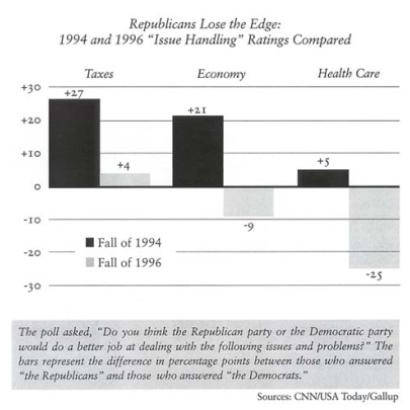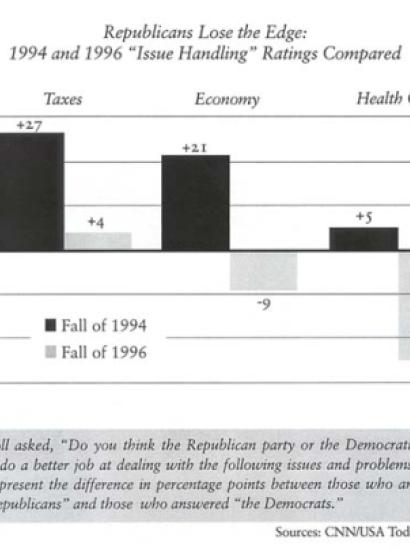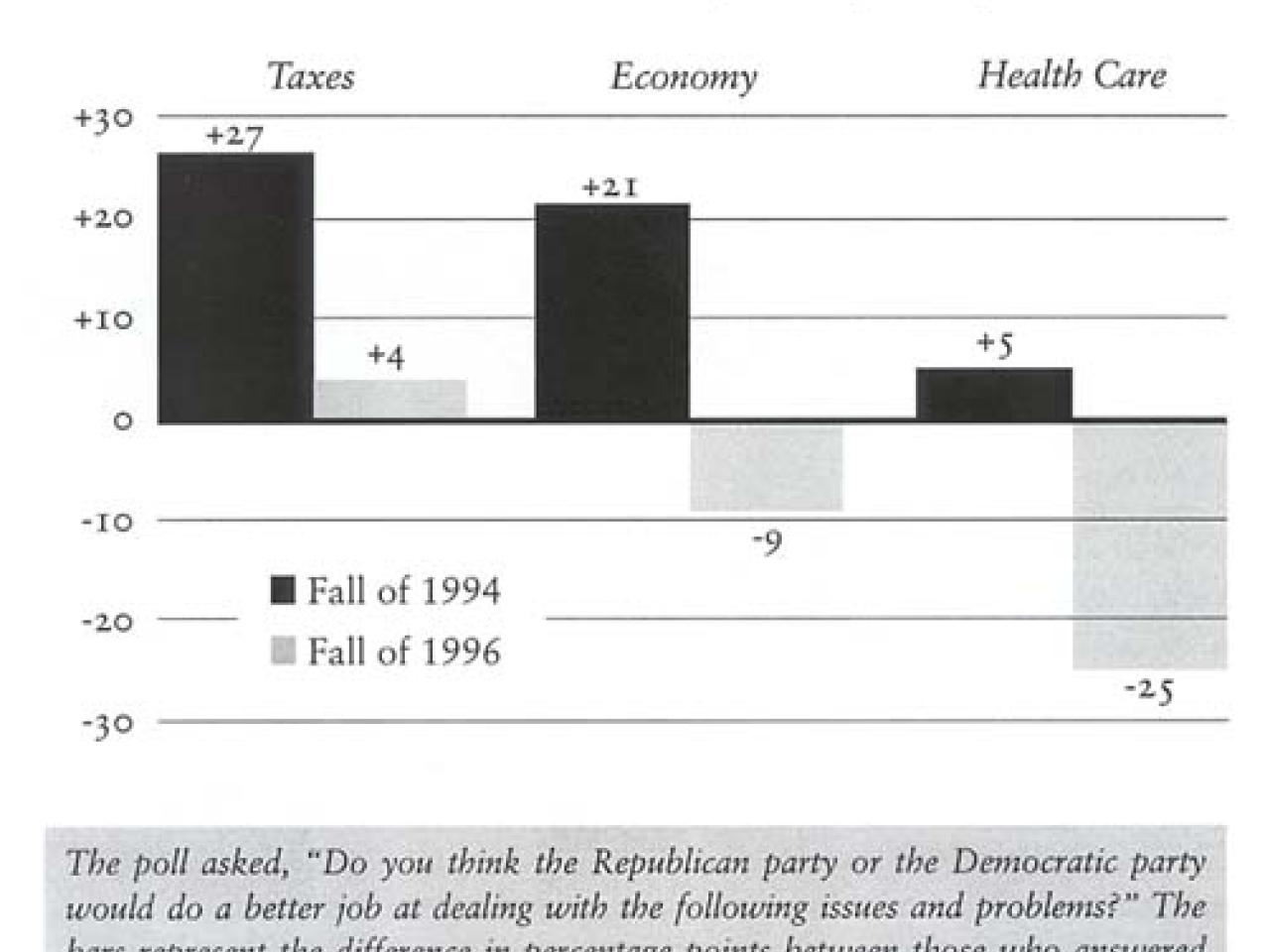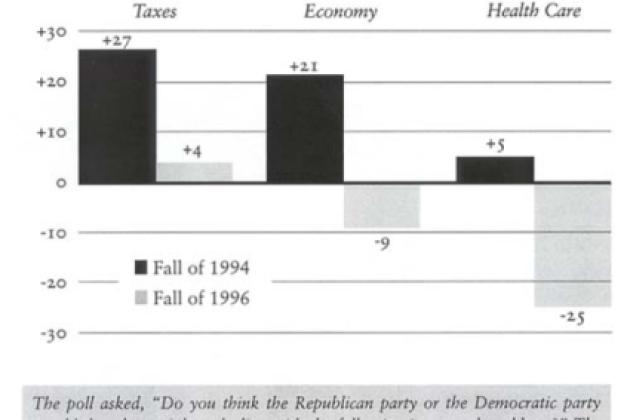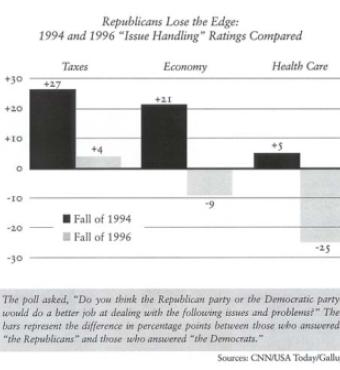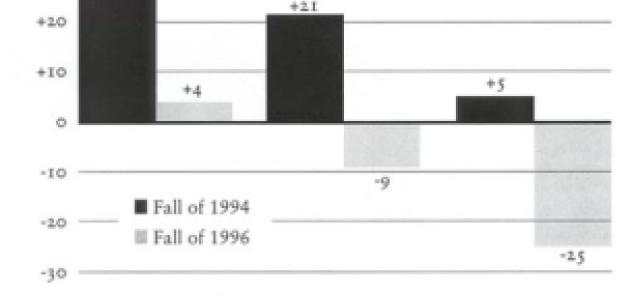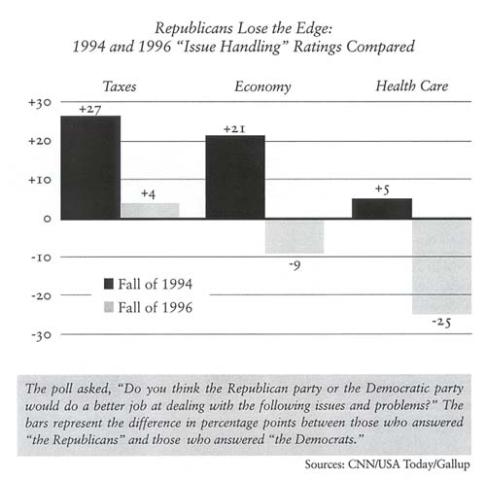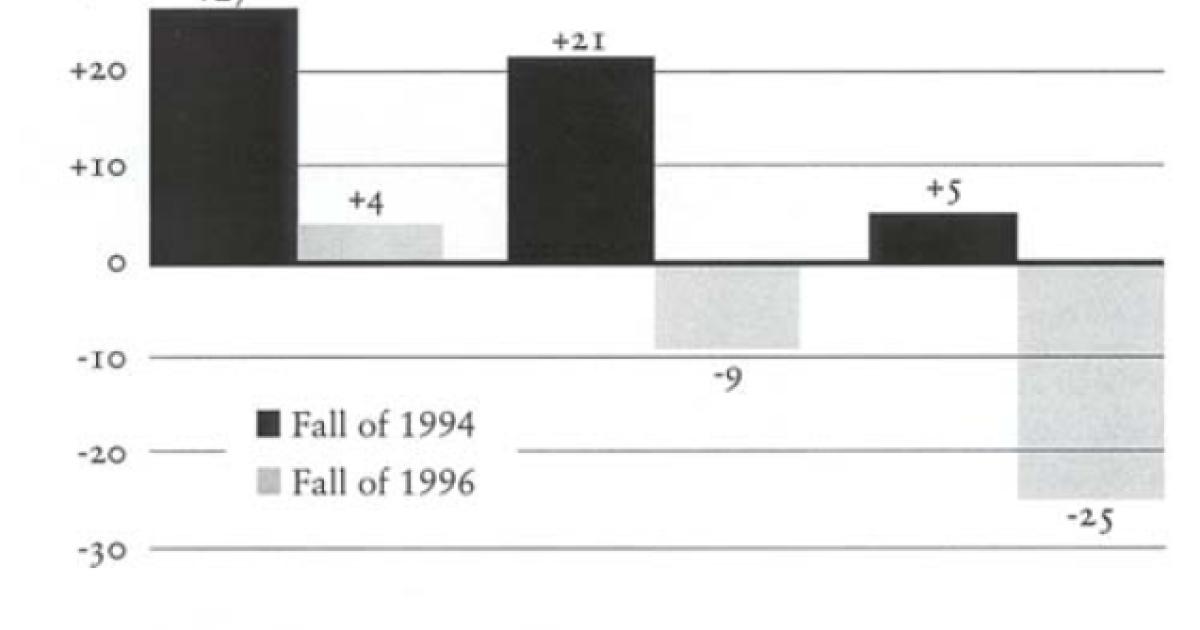- Contemporary
- Campaigns & Elections
- History
- Politics, Institutions, and Public Opinion
It is pardonable to be defeated, but never to be surprised.
— Frederick the Great
N
EWT GINGRICH STOOD before the TV cameras on election night 1998 confused, angry, and disoriented. He had expected to win a significant number of House seats, which would secure his speakership and his agenda for the next two years. He had weathered, he believed, the worst that anyone could throw at him — from a coup by his trusted advisors, to a massive Democratic effort to pursue ethics charges against him, to 120,000 negative television spots produced by organized labor and the Democrats. But he had survived, and he had set up the 1998 election just the way he wanted. Now he faced the cameras having suffered a huge defeat — and he didn’t know why.
In 1996, about two weeks before the election, Bob Dole, a true war hero and one of the most respected legislators ever to serve in Congress, realized he wasn’t going to win the presidency. In frustration, he blamed the American people, crisscrossing the country to tell them they were wrong. Inside the Dole campaign, it was referred to as the "Wake Up, America" tour. Just 18 short months earlier, it looked like any Republican would beat Bill Clinton, but Dole now faced a humiliating defeat, and he didn’t know why.
In 1994, Clinton and his staff huddled on election night — removed from the public. They had been handed a historic defeat. After having laid out a bold and ambitious series of proposals, Clinton had done something a Democratic president had not done since 1946. He had lost both the House and the Senate — and he didn’t know why.
How could these three very different political leaders be so far off in their expectations about the results of an upcoming election? The reason is that each had crafted a strategic vision and tactical plan based on assumptions that missed the most important shift in American political behavior since the 1920s. American voters now are largely unwilling to make political decisions based on liberal or conservative ideology — that is, by locating themselves somewhere on the left-right political spectrum and supporting the candidate located closest to them or opposing the candidate farthest from them. Voters have evolved new, highly personalized ways of choosing, and more often than not, they regard attempts to make them view the world in ideological terms as too constricting. Politics will never be the same again, and politicians who miss this change are apt to be left behind scratching their heads as the masters of this new politics emerge victorious at the polls.
Ideology and its discontents
T
HE BASIC PARADIGM of political decision-making since FDR has been ideological. Think of a straight line from left to right, with "liberal" at one end, "conservative" at the other, and varying shades of "moderate" in between. Candidates have tried to place themselves along that spectrum at a point that includes at least 50 percent of voters. Exactly where that point is varies considerably. Fifty percent plus one in a very liberal district (say, the Upper West Side of Manhattan) is very different from the same point in a conservative district (Orange County, California).
In an ideological world, politics and political appeal are largely a matter of the positions a candidate takes. Gun control: For it? Liberal. Against it? Conservative. To state the position is to make the pitch for support, because in an ideological world, voters know where they stand and respond to candidates accordingly.
Today, for some voters, a "conservative" or "liberal" label is a drawback, because many people now tend to view both terms — rightly or wrongly — as extreme. Nor is the solution for politicians somehow to take a "moderate" view, that is, simply a blend of liberal and conservative positions.
Increasingly, people do not see themselves as fixed somewhere on the political spectrum of left to right. Rather, they see the political spectrum as something outside of themselves, and in evaluating candidates, they do not respond merely to the stating of a position. On the contrary: They are responding to politicians who present a similar view of ideological politics — as alien to the real concerns of real people. They often resent those trying to advance ideological views as persons with agendas separate from and indifferent to their own. What they want, and what successful candidates are giving them, is a more personalized politics.
Origins
I
N PREPARATION for the 1984 campaign, Ronald Reagan’s pollster and strategist, Richard Wirthlin, conducted a study of how the American electorate was making political decisions. His insight was that people were beginning to make decisions in a much more personal,
values-based way. The way politicians frame an issue for voters is as important as the substance of the position they take. "Message development" is king.
Take a hypothetical example — an across-the-board tax cut. Never mind that conservatives would generally favor such a tax cut on principle, and liberals generally oppose it. People don’t respond merely, or even chiefly, ideologically. If they did, it would be enough for a politician to say, "I favor (or oppose) an across-the-board tax cut." People would then know as much as they need to make up their minds.
But voters are more inclined to respond favorably to a politician who does more than make his position clear. Increasingly, the successful politician is likely to be the one who places the issue in a more personal context. For example: "Voters will get to keep more of their own money." (On the negative side: "This tax cut will benefit the rich the most.") The next step is to connect the benefit to a personal consequence for voters. The candidate supporting the tax cut might talk about how people will have more money for their family, to pay for their children’s college, or to take care of elderly parents. The candidate against it might note that in order to pay for this tax break for the rich, it will be necessary to cut programs for families, college, and the elderly.
The question then becomes more intimate: Who can make the case for or against a particular policy proposal in the way that best resonates with most people’s personal values, the things of concern to them in their lives? In the example of a tax cut, those favoring it might try to connect with a person’s sense of self-esteem in the form of his ability to provide for his family. On the other side, avoiding cuts in programs might connect with people’s sense of personal security, since they might one day rely on those programs.
By this point, there is very little of an ideological nature going on here. Although conservative and liberal ideas are under consideration, they are accepted or rejected primarily on the basis of how they connect with people’s lives. The politician’s task is to make that connection — and the politician who does so will always have an advantage over a politician stuck in an ideological world where he thinks merely taking a position does the trick.
Wirthlin’s model looked something like this: Issue/Attributes connect to Issue/Voter Benefits connect to Personal Consequences connect to Personal Values. In this model, Issue/Attributes are the proposals and ideas politicians put forward — positions. Issue/Voter Benefits explain how these positions benefit people. Personal Consequences spell out the impact of these benefits on people’s goals. Personal Values take us to the heart of people’s hopes and concerns.
As Wirthlin understood, and later Dick Morris, voter decision-making has become much more complicated. This new personalized decision-making process has overwhelmed the simple, one-dimensional construct of ideology.
From ideological to personal
A
MERICANS GAVE MUCH of the credit for deliverance from the Great Depression to the liberalism of FDR, and liberalism dominated the political landscape for decades. Over the years, however, the country began a slow shift to the right, a shift that culminated in 1980 with the election of Ronald Reagan and a Republican Senate. In 1984, Reagan won the last avowedly conservative-liberal presidential contest, running against an opponent, Walter Mondale, who had announced he was going to raise taxes, thereby openly aligning himself with a liberal ideological perspective.
In 1988, the Democratic Party tried to dress up Michael Dukakis’s liberalism in the guise of "competence" in an effort to make the party’s ideology more palatable to voters. George Bush insisted that the "competence" tag was just liberalism trying to advance under a false flag. "Competence" didn’t survive the assault.
By 1992, however, a new kind of election was in the making as two events converged. Bill Clinton was working tirelessly to define himself as a new kind of Democrat, taking the party with him. Meanwhile, George Bush had driven up the cynicism of the American electorate by breaking his "no new taxes" pledge. He was punished in the primaries by conservatives, and then punished in the general election by the politically disaffected supporters of Ross Perot.
Clinton didn’t run an ideological campaign. Instead, using the slogan "Putting People First," he cast himself as a caring populist who understood the values and concerns of everyday people. Meanwhile, he castigated George Bush as elitist, out of touch with regular folks. Clinton even took on his own party’s liberal base, openly chastising the rap performer Sister Souljah.
The formula worked — well enough to take him to the White House. But once he got there, pressures from the traditional liberal constituency, including the Democratic Congress, mounted to move him leftward. He did embrace some "centrist" positions — for example, his wish to placate the bond market, in pursuit of lower interest rates. But for the most part he retreated from the personalized political style in which he campaigned and instead engaged in a series of clearly ideological battles. From gays in the military to a tax increase at the end of his first six months to a massive government-run health care program proposal a year later, Clinton found himself caught in an ideological web from which he could not extricate himself.
The ‘Revolution’ of 1994
H
AVING REJECTED LIBERALISM aving rejected liberalism in 1980, 1984, and 1988, the electorate had no intention of embracing it anew in 1992. By 1994, disappointed voters punished Clinton for betraying their trust, much as they had Bush, handing him the worst defeat a Democratic president has suffered since 1946. As Clinton sat with his advisors on election night in 1994, it became apparent that the assumptions he made in formulating political strategy for his first term were wrong. These assumptions were:
ù In the 1992 election, the country rejected conservatism in favor of a leader who would govern farther to the left.
ù By using class warfare to split the country, it would be relatively easy to garner the support of a majority of Americans for more liberal positions.
ù The American people would accept a big-government solution to health care.
ù By cooperating with the liberal Democratic leadership in Congress, the White House could enact its political agenda.
ù Policy successes would lead to political successes.
ù The country wanted big ideas as opposed to incremental improvement.
The assumptions here are classically ideological. Clinton was creating a left-oriented, class-focused, redistributionist program with massive government expansion as the centerpiece. Perhaps this is not what he had originally intended, but during the course of his first two years, especially trying to work with the liberal Democratic leadership in Congress, this is what his presidency became.
The election that followed was a repeat of the 1984 election, and Democrats were routed. The Republican victory, however, did not reflect a desire on the part of the electorate for a conservative ideological solution to national problems. The "Harry and Louise" ads that aired against the Clinton health care plan did as much as anything to set up Clinton for defeat in the fall. These ads, funded by the health insurance industry, created a new context for the health care debate far more favorable to Republicans and conservative positions. They connected to people’s personal fears about losing their doctors and their desire for reliable, quality health care. Opinion turned against the liberal approach because people felt connected to the conservative approach.
The damage of 1996
A
FTER THE 1994 VICTORY, Newt Gingrich strode into the limelight with a new vision of conservatism and quickly went to work on his ambitious agenda. But as did Clinton after the 1992 election, Gingrich misinterpreted his victory. The election of 1994 was a rejection of the liberal direction Clinton had tried to take the country; it was not an affirming election for conservatism. Republicans thought differently and set about the avowedly conservative, ideological project of reducing the size of government. This set the stage for the dramatic confrontation over the government shutdown of 1995.
In 1995, Clinton, who learned from his mistakes in 1993 and 1994, recovered and moved into "triangulation." The political strategy that goes by that name is widely misunderstood — namely, as a sort of "moderate" course between liberal Democrats and conservative Republicans on the political spectrum. In fact, triangulation is not an exercise in claiming the ideological middle ground; it is a strategy that rejects ideological points of view altogether, concentrating instead on making a connection with people.
Clinton was polling daily, and so he was aware of the public’s wariness of conservative ideology. In the fall, Clinton did something radical that was sneered at by many Republicans at the time. Although he had the communications firepower of the presidency behind him, he went on the air with a massive advertising campaign that bombarded the American people and echoed the themes coming daily from the Oval Office and Democrats on the Capitol Hill. Clinton’s message effectively changed the context of the political debate.
He approached the shutdown not by casting it in liberal/conservative terms but by connecting it to voter fears and concerns. His advertising portrayed him as a caring president desperately trying to keep Social Security checks and Medicare payments flowing, in the face of a narrow-minded, extreme opposition that cared more about politics than people.
Republicans, without the benefit of any polling, believed the country supported the idea of smaller government. The public may have. But people didn’t translate the shutdown into an effort to achieve "smaller government." Instead, they looked at it from a personal perspective. For some, a late Social Security check, a closed national park, or a delayed flight. For others, no passport, missing food stamps, a Medicare foul-up. Republicans talked about smaller government as a theoretical idea. Clinton talked about how the shutdown would affect people’s lives. That, not the abstract project of smaller government, is what people responded to.
Although many conservatives refused to admit it, Clinton’s success was staggering. By January 1996, Clinton’s advertising campaign had put the Republicans in a defensive position from which they have yet to recover. Supported by vigorous polling that gave him a blueprint for victory, Clinton shaped the political environment, connected to people’s fears and their wants, and won. Republicans, on the other hand, did virtually no polling and had little idea of how the public was reacting. They relied on their ideological instincts, and their instincts failed.
Republicans believed that, in any event, there was plenty of time to repair any image problems left over from the shutdown. They were half-right. Many voters don’t make up their mind on specific candidates until later in the election cycle. But by connecting with the voters early, Clinton and the Democrats were able to define the election issues on their terms and create a negative Republican "brand image" at the same time.
Just how successful was the Democratic effort? Look at the survey questions that ask which party will do a better job handling a particular issue. After 1994, Republicans had significant leads in a cross-section of issues. From 1994 to 1996, those leads evaporated (see below).
When election day arrived, the image of congressional Republicans that most voters took to the polls had been created by Dick Morris almost a year before.
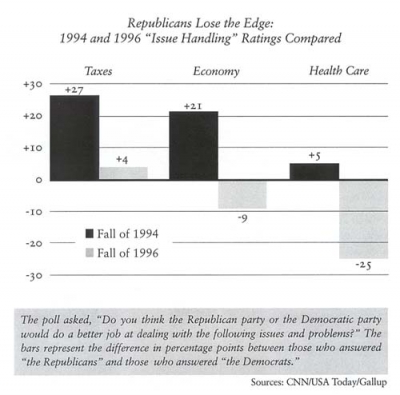
Bob Dole fared no better. The Dole campaign also misread the political tea leaves in the early months of 1996 and made a number of strategic assumptions that proved to be irrelevant or even wrong. These included:
ù The election could be won by labeling Clinton a liberal and Dole a conservative.
ù An emphasis on the contrast between Dole as hero and Clinton awash in scandal would drive voter behavior.
ù Republicans had become a majority in 1994, setting the stage for victory in 1996.
ù Americans are generally conservative.
ù The Reagan majority still existed and could be re-formed based on the right mix of positions — that is, ideologically.
ù Since voters don’t make decisions until the last month before election day, activities should be focused late in the campaign.
Some of these assumptions were, in fact, true. Dole was viewed as more conservative, more of a hero, and more a reflection of the ’94 Republican victory. The country was more conservative. But Bob Dole was utterly uncompetitive with Clinton in the ability to explain the connection between one’s positions and people’s lives. The result was decisive.
The 1998 surprise
O
NCE CLINTON DISCOVERED the efficacy of using personalized politics against ideological politics, he used it time and time again against the Republican majority with great effect.
That Republicans were truly lost after the 1996 elections was obvious. Gingrich, like Clinton and Dole before him, made a number of assumptions that proved disastrous:
ù In the sixth year of a presidency, the party out of the White House always picks up seats in Congress.
ù America believes in conservative ideas — all that is needed is an effective vision to engage them (a la Reagan).
ù The electorate would not focus on the election until the last month.
ù Public opinion research would have no value until the closing weeks of a campaign.
ù Personal disapproval of Clinton would negate Clinton’s high job approval.
ù Clinton’s job approval would decline by the time of the election.
ù A low-turnout election would favor Republicans.
ù Motivating the base to turn out would be critical for both parties.
ù Clinton, a liberal pretending to be moderate or conservative by stealing Republicans’ ideas, would revert to being liberal before the election to try to motivate his party’s base.
Like Dole’s assumptions, these were ideologically driven. Throughout 1998, Democrats talked in terms of people and values. Republicans talked in ideological terms. The negative image of the Republican Party established by Clinton during the budget shutdown and reinforced in the 1996 election still haunted Republicans in 1998. They were viewed as single-minded, partisan, inflexible.
In addition, Republicans, still living in an ideological world, refused to believe that the Democratic Party had really changed. For their ideological construct to remain valid, Republicans had to believe that Democrats were flying under a false flag to fool voters but would revert to type. Democrats didn’t. Many Democratic leaders certainly remain liberals, but the Democratic Party, like many other left-oriented parties around the world, was forced to change after the success of conservatism in the 1980s.
Finally, going into the fall of 1998, Republicans spent a significant amount of time on impeachment, something that two-thirds of the public clearly opposed. The anti-impeachment sentiment, however, was never really relevant to the thinking of the Republican leadership. In fact, on balance they regarded it as a political plus, focused as they were on the party base, with which impeachment was popular, as the key to the election. And as it happened, they believed that neither impeachment, nor a lack of legislative accomplishment — in fact, nothing — could alter the historical pattern according to which Republicans would pick up seats.
Even on Election Day, Republicans in the leadership did not see the disaster that was about to hit them. Predictions of a 30-seat gain still carried credibility among many. The electorate dealt their confidence in historical inevitability a crushing blow.
Lessons learned the hard way
I
N THE NEW WORLD of personalized politics, voter decision making has changed in very fundamental ways. The past three elections have taught us three crucial lessons:
In order to lead, one must have a solid understanding of the American people. Leading means more than just taking a position. It means listening closely to what people have to say. In the past few years, dictates of ideology have led political operatives, especially Republicans, to disdain polling. Democrats, by contrast, have listened to public opinion because they want to understand the complex interaction of many proposals on issues and how the public feels about them. For Democrats, polls have been strategic tools that give them the ability to understand and better communicate with the electorate and make the all-important connection to voters’ personal concerns. Republicans have used polling unevenly and narrowly. They see its value mainly in telling them how they are doing, whether an advertisement’s message is working. And when the news from polls is bad, they often react by questioning the validity of the survey itself.
Because most Republicans have grown up politically in an ideological world, they see issues in terms of black or white; right or wrong; conservative or liberal. For Republicans, polling is purely tactical. They are suspicious of any effort to test issues themselves. This lack of interest in public opinion has made the Republican Party tone deaf in many situations, whether developing legislative plans or waging political campaigns.
Recently, we have heard Republicans saying, "I don’t listen to polls. I do what I think is right." Since polling is the process of understanding what Americans think, a rewording of that statement might be: "I don’t listen to Americans. I do what I think is right." Or at least that’s what many Americans think they’re saying. If Republicans are going to win, making a badge of honor out of refusing to listen to the American people is foolish.
Polls don’t replace principles or ideas. They are tools, like television advertising or direct mail, that help candidates and parties communicate better with voters. In an ideological world, they were important in measuring party and ideological affiliation, the strength of ideas, and political progress. In a more personalized political culture, they are essential to understanding how to make the connection between political positions and voters’ personal concerns. Never has public opinion been more important or more difficult to discern.
Public opinion is dynamic, not static. In the world of ideology, public opinion is regarded as largely fixed. One is either a liberal, a conservative, or something in between, and that won’t change. The month before the election is the heart of an ideological campaign, at which time candidates define themselves and try to prevent their opponents from creating a new image.
In our world of personalized politics, successful strategists will understand that public opinion is constantly changing. It can be shaped. A key part of any successful campaign is likely to be its earliest phase, perhaps before the opponent even realizes that a campaign is under way, when strategists shape the public view of the context of the election by engaging voters in personal terms.
Message delivery occurs all the time. There are opportunities every day to shape the context of the next election.
Conservative ideas — and liberal and centrist ideas, too — will be successful only to the extent they have a personal appeal for people. Consider an example: It frustrates Republicans endlessly that most voters agree with them that responsibility for education should generally remain at the state and local level, yet in survey after survey, the same voters overwhelmingly have more confidence in the Democratic Party on the issue.
Republicans think that because they are right on the underlying principle of local control, this should naturally translate into political success — a classic ideological view. What they fail to understand is that voters can disagree with Clinton or the Democrats on one or more of the basic elements of an issue, but their resistance can be overcome with other proposals that create a different political context and connect with people personally. People also care about class size, a safe learning environment, quality instruction, and discipline. So when Clinton focused on 100,000 new teachers for smaller class size, 5,000 new schools for a safer environment, national education standards to ensure quality, and school uniforms to minimize distractions, people were prepared to forgive him on local control.
Ideological conservatives tend to see voters who support the concept of local control and also support Clinton’s education policies as inconsistent and therefore in need of education themselves. But the electorate doesn’t see education, or most issues, in "either/or" terms. It’s the package that counts — including the packaging.
Voters will likewise respond to conservative ideas — if politicians will show them the benefit of those ideas in their lives. But they are less and less likely to embrace a "conservative agenda" just because it is conservative. If conservatives can’t or won’t explain how conservative ideas will work for people, people in our personalized political culture are likely to turn to the ideas of those who can and will.







